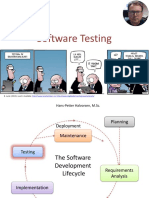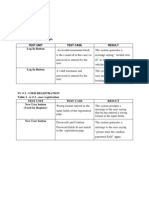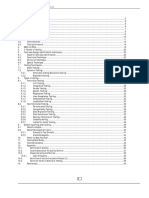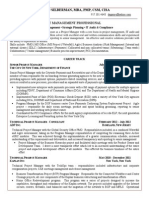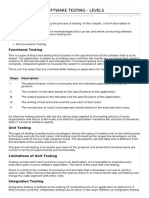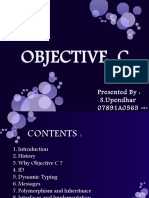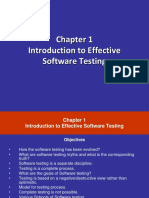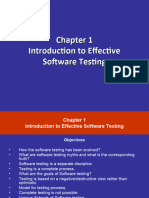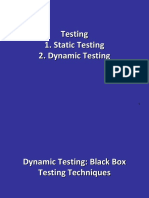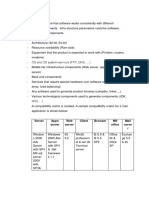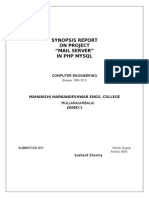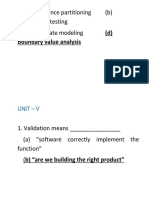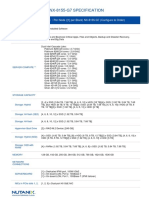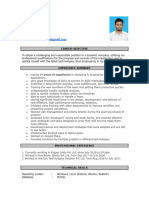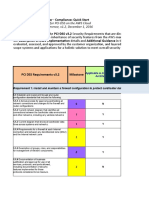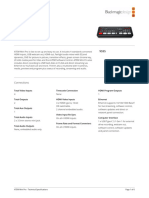Introduction to Effective
Software Testing
1
� Introduction to Effective Software Testing
Objectives
• How the software testing has been evolved?
• What are software testing myths and what is the corresponding
truth?
• Software testing is a separate discipline.
• Testing is a complete process.
• What are the goals of Software testing?
• Testing is based on a negative/destructive view rather than
optimistic.
• Model for testing process.
• Complete testing is not possible.
• Various Schools of Software testing.
2
� Evolution of ofSoftware
Evolution Testing
Software Testing
• In the early days of software development, Software Testing was
considered only as a debugging process for removing the errors
after the development of software.
• By 1970, software engineering term was in common use. But
software testing was just a beginning at that time.
• In 1978, G.J. Myers realized the need to discuss the techniques of
software testing in a separate subject. He wrote the book “The Art
of Software Testing” [2] which is a classic work on software testing.
• Myers discussed the psychology of testing and emphasized that
testing should be done with the mind-set of finding the errors not to
demonstrate that errors are not present.
• By 1980, software professionals and organizations started talking
about the quality in software. Organizations started Quality
assurance teams for the project, which take care of all the testing
activities for the project right from the beginning.
3
� Evolution of ofSoftware
Evolution Testing
Software Testing
• In the 1990s testing tools finally came into their own. There was
flood of various tools, which are absolutely vital to adequate testing
of the software systems. However, they do not solve all the
problems and cannot replace a testing process.
• Gelperin and Hetzel [79] have characterized the growth of software
testing with time. Based on this, we can divide the evolution of
software testing in following phases:
4
�Evolution of Software Testing
5
� Evolution of Software Testing
• The evolution of software testing was also discussed by Hung Q.
Nguyen and Rob Pirozzi in a white paper [81], in three phases
namely Software Testing 1.0, Software Testing 2.0 and Software
Testing 3.0. These three phases discuss the evolution same as in
the earlier phases we described. According to this classification, the
current state-of-practice is Software Testing 3.0. These phases are :
6
� Evolution of Software Testing
Software Testing 1.0
• In this phase, software testing was considered to be just a single
phase to be performed after coding of the software in SDLC. No
test organization was there. A few testing tools were present but
their use was limited due to the high cost. Management was not
concerned with the testing as there was no quality goal.
Software Testing 2.0
• In this phase, software testing gained the importance in SDLC
and the concept of early testing was also started. Testing was
evolving into the direction of planning the test resources. Many
testing tools were also available in this phase.
7
� Evolution of Software Testing
Software Testing 3.0
• In this phase, software testing is being evolved in the form of a
process which is based on the strategic effort. It means that there
should be a process which gives us a road map of the overall
testing process. Moreover, it should be driven by the quality goals
in mind so that all controlling and monitoring activities can be
performed by the managers. Thus, management is actively
involved in this phase.
8
� Software Testing Myths
Software Testing Myths
• Testing is a single phase in SDLC performed after
coding.
• Testing is easy.
• Software development is of more worth as compared to
testing.
• Complete testing is possible.
• The testing starts after the program development.
• The purpose of testing is to check the functionality of the
software.
• Anyone can be a tester.
9
�Software Testing Goals
10
�Testing produces Reliability and Quality
11
�Quality leads to customer satisfaction
12
�Testing controlled by Risk factors
13
� Psychology for Software Testing
• Software testing is directly related to human psychology. Though
software testing has not been defined till now, but most frequently it
is defined as –
“ Testing is the process of demonstrating that errors are not
present.”
• So the purpose of testing is to show that software performs its
intended functions correctly. This definition is correct, but partially.
• If testing is performed keeping this goal in mind, then we cannot
achieve the desired goals (described above in the previous section)
as we will not be able to test the software as a whole.
• It may hide some bugs.
• If our goal is to demonstrate that a program has errors; we will
design the test cases which have higher probability to uncover the
bugs instead of showing that software works.
“Testing is the process of executing a program with the intent
of finding errors.”
14
� Psychology for Software Testing
• We should not have a guilty feeling for our errors
and for human beings.
• This psychology factor brings the concept that
we should concentrate on discovering and
preventing the errors and not to feel guilt about
them.
• Therefore, testing cannot be a joyous event
unless you cast out your guilt.
15
� Software Testing Definitions
• “Testing is the process of executing a program with the
intent of finding errors.”
- Myers [2]
• “A successful test is one that uncovers an as-yet-
undiscovered error.”
- Myers [2]
• “Testing can show the presence of bugs but never their
absence.”
- W. Dijkstra [125].
16
� Software Testing Definitions
• “Testing is a concurrent lifecycle process of engineering, using and
maintaining testware (i.e. testing artifacts) in order to measure and
improve the quality of the software being Tested.”
- Craig [117]
• “Software testing is a process that detects important
bugs with the objective of having better quality software.”
17
�Model for Software Testing
18
�Effective Software Testing vs Exhaustive Software
Testing
19
�Effective Software Testing vs Exhaustive Software
Testing
• The domain of possible inputs to the software is
too large to test.
• Valid Inputs
• Invalid Inputs
• Edited Inputs
• Race Conditions
20
�Effective Software Testing vs Exhaustive Software
Testing
21
�Effective Software Testing vs Exhaustive Software
Testing
There are too many possible paths through the
program to test.
1for (int i = 0; i < n; ++i)
2{
3 if (m >=0)
4 x[i] = x[i] + 10;
5 else
6 x[i] = x[i] - 2;
7}...
22
�Effective Software Testing vs Exhaustive Software
Testing
• if n is 20, then the number of paths will be 220 + 1, i.e.
1048577.
23
�Effective Software Testing vs Exhaustive Software
Testing
• Every Design error cannot be found.
24
�Software Testing as a Process
25
� Software Testing as a Process
• An organization for the better quality software must adopt a testing
process and consider the following points:
• Testing process should be organized such that there is enough time
for important and critical features of the software.
• Testing techniques should be adopted such that these techniques
detect maximum bugs.
• Quality factors should be quantified so that there is clear
understanding in running the testing process. In other words,
process should be driven by the quantified quality goals. In this way,
process can be monitored and measured.
• Testing procedures and steps must be defined and documented.
• There must be scope for continuous process improvement.
26
� Schools of Software Testing
The idea of schools of testing was given by Bret Pettichord [82]. He has
proposed the following schools:
• Analytical School of Testing
This school defines software testing as a branch of computer
science and mathematics.
27
� Schools of Software Testing
• Standard School of Testing
The emphasis is on measurement of testing activities to track the
development progress.
This school defines software testing as a managed process.
28
� Schools of Software Testing
Quality School of Testing
This school defines software testing as a branch of software quality
assurance.
The implications of this school are:
• It prefers “Quality Assurance” term over “Testing”
• Testing is a stepping stone to “process improvement”.
29
� Schools of Software Testing
• Context-driven School of Testing
This school is based on the concept that testing should be
performed according to the context of the environment and project.
The testing solutions cannot be same for every context.
• Agile School of Testing
This type of school is based on the testing of software which is being
developed iterative method of development and delivery. In this type
of process model, software is delivered in a short span of time and
based on the feedback more features and capabilities are added.
The focus is on satisfying the customer by delivering working
software quickly with minimum features and then improvising on it
based on the feedback.
30


